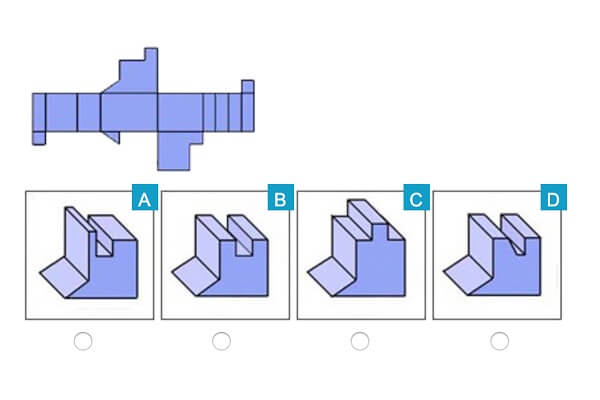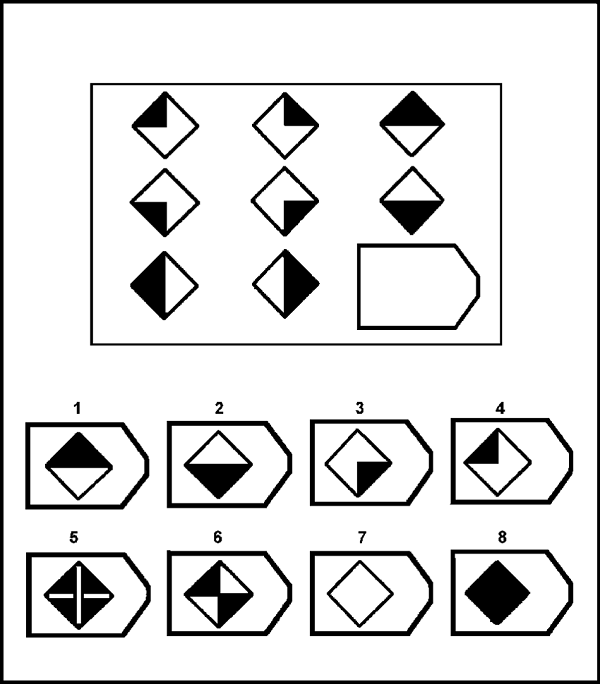Spatial reasoning (sometimes called spatial intelligence) is the mental ability to think about objects in three dimensions or transform 2D flat graphic representations into 3D objects. Usually, in academic, clinical, or recruitment environments, experts use a spatial reasoning test to assess individuals’ spatial awareness and visual-spatial skills. Let’s talk about spatial skills, the jobs that benefit most from them, the application of spatial skills tests, and more!
What Does Spatial Intelligence Mean?
As you know, Gardner’s multiple intelligence theory opened a new world for psychologists and recruiters alike back in the eighties. The idea is that spatial reasoning is just one of many human mental abilities or intelligence areas that we can demonstrate and measure.
In current pre-employment practice, we use specialized ability tests and cognitive tests to measure candidates’ particular skills we deem crucial. We use these batteries because they are good predictors of job performance.
More often than not, we recruit people who demonstrate high scores of spatial ability who can draw better conclusions about objects from a limited amount of information or think about how objects look and behave when rotating. They are good with shape recognition and manipulation, visual comparisons, mapping, block and reflection reasoning, and more.
You can easily figure out that spatial intelligence and spatial reasoning are crucial mental abilities for many jobs and roles.
If you remember, we already mentioned spatial reasoning as one of the many mental abilities we assess in the pre-employment stage. Today, we will get into more details and discuss applying a spatial reasoning test to evaluate spatial skills in candidates.
What is a Spatial Reasoning Test?

A spatial reasoning test is a standardized computer-based (or online) non-verbal instrument – or battery of tests – measuring individuals’ spatial reasoning. Usually, such tests challenge the candidate to manipulate shapes, 2D, and 3D objects to find answers and problem solutions.
Candidates take the test on a computer at home, at the employer’s office, in your office, or at an assessment center. The tests’ design varies, but most of them are multiple-choice questions that applicants need to answer in a specific amount of time.
Once the candidates offered their answers, the computerized spatial reasoning test calculates the scores and generates the results. In this manner, recruiters can compare applicants’ scores and make more focused decisions regarding the next recruiting steps.
Spatial Reasoning Test Examples

One of the most famous such reasoning tests is Raven’s Progressive Matrices.
Many psychologists used it to assess general intelligence in the past. Now, the RPM became one of many tests to evaluate visual-spatial intelligence rather than overall intelligence.
In recruiting, the spatial reasoning test is just one of the many HR assessment tools experts use to ensure they hire talent and match the best candidate with the open position.
Some could argue that spatial reasoning tests resemble abstract reasoning tests, mechanical reasoning, and Matrix reasoning because they all prompt the candidate to manipulate pictograms, figures, abstract visual patterns, etc. However, the resemblance stops here.
A spatial reasoning test usually consists of a handful of instruments that evaluate a person’s ability to:
- Assemble/disassemble previously rotated object;
- Solve problems related to objects viewed from different angles;
- Manipulate surfaces/objects with different surface texture or markings;
- Work with cubes in two or three dimensions;
- Solve puzzles (shape matching ability);
- Solve problems related to maps, plans, labyrinths, etc.
When Do We Apply a Spatial Reasoning Test?
Most often than not, organizations and recruiters use spatial reasoning assessment tools to screen candidates before scheduling the first interview. You will work with some companies that want the spatial skills testing to occur before the second interview, but such cases are rare.
So why do more and more employers introduce spatial reasoning tests in the candidate screening process?
Because they save money and time as they narrow down the candidate pool to only those who show measurable skills crucial to the job tasks.
What is Spatial Reasoning Good For and Why Do We Test It?
Before answering why spatial reasoning is important (although we are sure you know already), we have to return to the definition. Spatial intelligence (or spatial reasoning) is the human ability to visualize, imagine, differentiate, and mentally operate with objects in two or three dimensions.
People who rock a spatial reasoning test have the mental prowess of understanding, manipulating, and transforming complex visual-spatial data to interpret abstract concepts into concrete ideas or actions.
Are you still asking yourself what spatial reasoning is good for in the hiring process? As recruiters, we have to consider a spatial reasoning test when we need to find certain experts for specific domains. Such tests and other complex assessment instruments (cognitive assessment tools and other skills tests) help us hire spatial thinkers who make the best matches for those positions.
In this context, the next question becomes…
Which Career Choices Make the Best Use of Spatial Reasoning Skills?

Why are spatial skills important? Let’s answer this question first and put it into a psychological and educational context.
Visual-spatial skills allow us to perceive the visual information in the environment, to represent it internally, and integrate it with past experiences, to derive meaning and understanding, and to perform manipulations and transformations on those perceptions. These skills are important in thinking abstractly, visualizing verbal information, and recognizing how details are related to big picture ideas. Weaknesses in this area can impact basic skills such as letter formation, note-taking, and simple math computation, as well as more complex skill areas such as reading comprehension, math (e.g., estimation, geometry, trigonometry, calculus), and social skills.
We understand why spatial skills are crucial for a child and a student’s development. But what about adults looking for jobs? Here is where we come in as recruiters and human resources experts.
What Jobs Use Spatial Reasoning?
In some cases, spatial reasoning skills are the bread and butter of certain jobs. Granted, we all use some of our spatial intelligence, spatial orientation, spatial awareness, etc., during the workday. However, what experts call “spatial thinkers” – the ones with great spatial ability scores – are individuals whose brain connections help them excel in certain careers. Here are some examples!
- Architecture;
- Geosciences and environmental engineering;
- IT;
- Archeology;
- Civil and industrial engineering;
- Surveying;
- Graphic design, fashion design, etc.;
- Advertising;
- Hairstyling;
- The military, police, air traffic control, or emergency services (with an emphasis on mapping, 2D plan rotations, route planning and following, etc.);
- Professional driving;
- Industrial machinery mechanics;
- Plumbing, electricity, construction services;
- Landscaping services;
- Scientific research (biochemistry, lab technology, genetics, etc.);
- Astronomy and space engineering;
- Visual arts (animation, filmmaking, directing, multimedia creation, etc.)
As you can see, challenging a candidate to pass a spatial reasoning test with excellence is a surefire way to hire not only the best possible engineers but also the most talented artists.
Can One Improve Their Spatial Reasoning Skills?

Spatial skills and spatial intelligence are very hot topics in education and developmental psychology today. Studies found that early signs of spatial skills in children are excellent predictors for certain career paths having everything to do with spatial reasoning.
However, as recruiters and executives, we have to know if we can train spatial reasoning and help employees reach better spatial skills. Professional HR experts do not limit their jobs to finding the right candidates for the right jobs and help employees throughout their careers to get better positions and roles.
Recent research found that young adults could improve their spatial reasoning skills with practice. In other words, companies who design employee development programs should consider the fact that spatial reasoning is trainable – especially when they hire young candidates for junior positions.
Using a spatial reasoning test to understand how the skills evolved in an individual after gaining some work experience is vital for promotion and employee benefits programs.
Bottom Line
The use of a spatial reasoning test has become increasingly important in pre-employment assessment. Many companies and research institutes use them to monitor the growth of such spatial skills throughout internship programs or employee training programs. As recruiters, it is our job to match candidates with job demands, so we cut down recruiting times and budgets while reducing employee turnover.
But can you use a single spatial reasoning test to know that a candidate will also be a rock star in an engineering job? Of course not. For this reason, we never use a single test or battery.
Our recommendation is to mix spatial reasoning tests with numerical reasoning tests, matrix reasoning, cognitive ability assessments, structured interviews, logic ability evaluations, and other skills test to predict job performance.
Now, it is your time to speak your mind! Have you ever used a spatial reasoning test to assess candidates for technical, engineering, and other “hard science” jobs? Did you find the instruments useful? Did they prove to be valid job performance indicators? We would love to hear your thoughts on this topic!
References
Anne U. Gold, Philip M. Pendergast, Carol J. Ormand, David A. Budd, Karl J. Mueller. Improving spatial thinking skills among undergraduate geology students through short online training exercises. International Journal of Science Education, 2018; 1 DOI: 10.1080/09500693.2018.1525621.
Kastens, K.A. and T. Ishikawa (2006). Spatial Thinking in Geosciences and Cognitive Sciences, in C. Manduca and D. Mogk (Eds.), Earth & Mind: How Geoscientists Think and Learn about the Earth. Geological Society of America Special Publication 413.
Uttal, David & Meadow, Nathaniel & Tipton, Elizabeth & Hand, Linda Liu & Alden, Alison & Warren, Christopher & Newcombe, Nora. (2012). The Malleability of Spatial Skills: A Meta-Analysis of Training Studies. Psychological bulletin. 139. 10.1037/a0028446
Wai, J., Lubinski, D., & Benbow, C. P. (2009). Spatial ability for STEM domains: Aligning over 50 years of cumulative psychological knowledge solidifies its importance. Journal of Educational Psychology, 101(4), 817–835. https://doi.org/10.1037/a0016127


